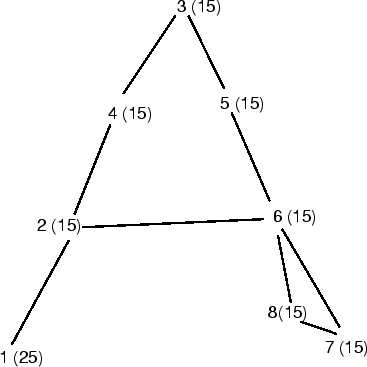The problem can be formally stated as follows:
Definition
Given a graph ![]() , let each vertex
, let each vertex ![]() have a load
have a load ![]() associated with it. The flow calculation problem is to find the amount of migrating load
associated with it. The flow calculation problem is to find the amount of migrating load
![]() along each edge
along each edge ![]() , such that
after the migration, the load on each vertex is the same. That is
, such that
after the migration, the load on each vertex is the same. That is
The graph here is the so called processor graph
of the partitioning. Each vertex of the processor graph
corresponds to a subdomain
(or a processor) and two vertices are linked by an edge if the two subdomains
share a boundary. Figure 14 shows the processor graph
corresponding to the partitioning in Figure 13 (b).
The load ![]() can simply be taken as the
number of nodes in the subdomain
can simply be taken as the
number of nodes in the subdomain ![]() . Figure 14 shows that
subdomain 1 has a load of 25 nodes, whilst others have 15 nodes each.
In the following the terms vertex and processor
are used interchangeably.
. Figure 14 shows that
subdomain 1 has a load of 25 nodes, whilst others have 15 nodes each.
In the following the terms vertex and processor
are used interchangeably.
 |
It is noted that the flow calculation problem does not have a unique
answer. This is because the solutions are given by a linear
system (9), with ![]() as the
unknown. There are
as the
unknown. There are ![]() equations (out of these,
equations (out of these, ![]() are independent),
and
are independent),
and ![]() unknowns. As there are
usually more edges than vertices in a graph (that is,
unknowns. As there are
usually more edges than vertices in a graph (that is, ![]() ),
there are usually more unknowns than equations and so the answer
to the problem is not unique.
),
there are usually more unknowns than equations and so the answer
to the problem is not unique.
This flow calculation problem has been studied by many authors [4,6,14,28,43,44,41,78,88,89]. Apart from parallel unstructured mesh based applications, it has appeared in areas such as parallel molecular dynamic simulation [7,55]. Some of the algorithms are discussed in the following.